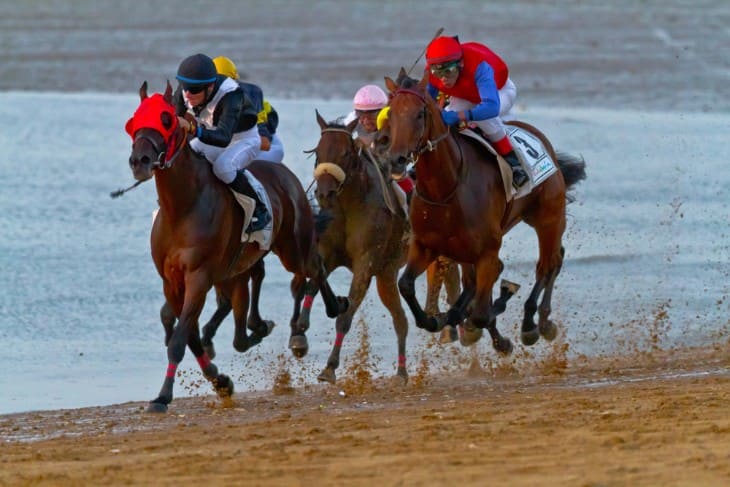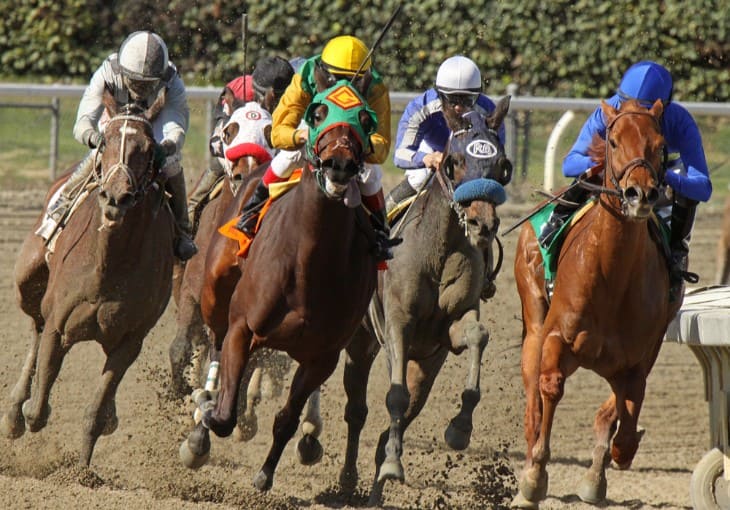Welcome to the dynamic world of horse racing. Here, speed meets strategy, creating a unique experience for both seasoned enthusiasts and newcomers. As you hear the crowd and the horses racing, you'll quickly understand the excitement of the race, the beauty of the horses, and the longstanding history of this celebrated British sport.
The Thrilling World of Horse Racing
Horse racing features a mix of colors from jockey uniforms, the consistent sound of galloping horses, and the enthusiastic reactions of spectators as horses approach the finish line. This sport has attracted enthusiasts for centuries. Events like the Derby and the Grand National each have their distinct significance and appeal. The combination of the horse's strength and the jockey's skill ensures every race holds interest.
Behind the races, there's a significant amount of planning and strategy. Owners, trainers, and jockeys prepare their horses thoroughly, taking into account various factors such as race conditions, the quality of the track, and weather changes. Accurate timing, maintaining the right pace, and managing speed and stamina are essential aspects that determine the race's outcome.

A Brief History of British Horse Racing Tradition
To truly appreciate the magnificence of horse racing, one must delve into its rich tapestry of history. The roots of British horse racing date back centuries, entwined with the nation's culture and aristocratic heritage. In the 12th century, knights and nobles would test the prowess of their horses in impromptu races, laying the foundation for what would later become a celebrated pastime.
By the 17th century, organized horse racing emerged as a formal sport, with the establishment of the first racecourses. The reign of Queen Anne saw the creation of Ascot Racecourse in 1711, a venue that remains synonymous with elegance and prestige. As the sport gained popularity, it became a playground for the upper echelons of society, who flocked to the racecourses, adorned in their finest attire, to witness the spectacle.
The introduction of the Epsom Derby in 1780 marked a turning point, cementing horse racing as a national fascination. The Derby's prestigious status as the "Blue Riband" of the turf attracted attention from all walks of life, transcending class barriers and uniting the nation in shared excitement. This era also saw the inception of the Grand National, a steeplechase like no other, demanding courage, skill, and a dash of luck from both horse and rider.
The Different Types of Horse Races Explained
As you step into the world of horse racing, you'll encounter a diverse array of races, each with its own unique characteristics and challenges. From the lightning-fast sprints to the grueling tests of stamina, horse racing offers a variety that keeps spectators on the edge of their seats.
One of the most iconic race formats is the Flat Race, where horses compete on a level track, showcasing their raw speed and agility. These races are often a showcase of elegance and finesse, as jockeys guide their mounts towards the finish line in a breathtaking display of synchrony. The pinnacle of Flat Racing is the Epsom Derby, a true test of pedigree and potential, where thoroughbreds battle it out for glory and honour.
In contrast, National Hunt Racing adds an exhilarating twist with jumps and obstacles scattered across the course. The Grand National, held at Aintree, is the epitome of National Hunt Racing, presenting a unique blend of athleticism, courage, and strategy. The heart-stopping sight of horses soaring over fences and ditches creates an atmosphere unlike any other, as spectators hold their breath in anticipation.
Beyond these, there are also endurance races, known as Long Distance Races, where horses showcase their stamina over extended distances. Then there are the sprints, where speed is paramount, and the races unfold in a flurry of thundering hooves and adrenaline-fueled dashes.
Understanding the Horses: Breeds, Training, and Racing Classifications
Horses are the central figures in horse racing and undergo extensive breeding and training to excel on the racetrack. Different breeds have distinct strengths which influence the types of races they participate in.
For instance, the Thoroughbred is primarily chosen for Flat Racing because of its renowned speed and elegance. They are conditioned for fast runs and have training regimes to build their muscles, improve their cardiovascular health, and hone their racing techniques.
On the other hand, National Hunt Racing features horses that can handle both racing and jumping over obstacles. Breeds like the strong Irish Draught or the adaptable Thoroughbred-Cross are common in these races due to their skillset.
When watching horse racing, you'll see that horses are categorized based on their past performance in races. These categories, such as Novice, Handicap, or Group races, are designed to ensure fairness and competition. Being familiar with these classifications can enhance the viewer's understanding and appreciation of the race.
The Art of Placing Bets: A Beginner's Guide to Wagering
Betting is a way for fans to get more involved in horse racing, adding an extra element of excitement to the races. If you're new to betting, understanding the basics is essential to have a positive experience.
A good starting point is the race card. This is a detailed guide offering information about each horse, its jockey, and recent race outcomes. By reviewing this card, you can gain insights into the horse's performance history, its preferred tracks, and other factors that might impact the race results.
There are various bets to explore. The Win bet is simple: you're betting on which horse will come in first. The Each-Way bet is a combination of a Win and a Place bet. With a Place bet, you're wagering on a horse to finish in one of the top positions, typically first, second, or third. An Exacta bet, on the other hand, requires you to predict the first two horses in their exact finishing order.
As a novice, it's wise to start with simple bets before delving into the more complex options. Additionally, setting a budget and sticking to it ensures that your wagering experience remains enjoyable and responsible.

Dress Code and Etiquette at the Racecourse
When attending a horse racing event, it's not only about the races but also about participating in a long-standing tradition. Being familiar with and following the dress code and racecourse manners can help you make the most of your day.
Most racecourses have a dress code, generally leaning towards formal wear. For men, this often includes suits, blazers, and ties. Women typically wear dresses, and many choose to wear hats or fascinators. Ascot, for example, has specific dress guidelines, especially focusing on women's headwear.
Beyond clothing, it's essential to be aware of and follow general etiquette at the racecourse. This includes being quiet during races, limiting mobile phone use, and practicing good sportsmanship. Such behavior ensures everyone can enjoy the event in a respectful environment.
By adhering to the dress code and practicing proper etiquette, you can fully immerse yourself in the horse racing experience, regardless of whether it's your first time or you're a regular attendee.
Famous British Racecourses and Iconic Races
The UK is home to several esteemed racecourses, each having its unique history and significance in horse racing. These venues have seen many memorable racing moments over the years.
Ascot Racecourse, located in the scenic countryside of Berkshire, is particularly notable. It is famous for the Royal Ascot meeting, a five-day event marked by its fashion, top-tier racing, and presence of the royal family. The Gold Cup, a major event during the meeting, showcases the essence of horse racing with its combination of skill and determination.
Aintree Racecourse, home to the revered Grand National, offers a thrilling blend of excitement and unpredictability. The Grand National, a grueling steeplechase that spans an awe-inspiring four and a half miles, captures the hearts of millions with its tales of bravery and camaraderie. The roar of the crowd as horses leap over the iconic fences reverberates through history.
Newmarket, known as the headquarters of British racing, is steeped in tradition and prestige. The Rowley Mile and the July Course provide the backdrop for exhilarating contests such as the 2000 Guineas and the July Cup. These races test the mettle of the finest Thoroughbreds, showcasing the evolution of the sport over time.
York Racecourse, nestled within the historic city walls, offers a unique blend of heritage and modernity. The Ebor Festival, a highlight of the racing calendar, is a celebration of world-class racing, fashion, and entertainment. The Ebor Handicap, a thrilling handicap race, exemplifies the competitive spirit that defines horse racing.
The Jockeys: Skill, Strategy, and the Role of Riders
Jockeys play a pivotal role in horse racing, navigating and directing the horses throughout the race. These riders are crucial to the sport, ensuring each horse reaches its full potential during the race.
Their role isn't just about riding; jockeys must strategize and make quick decisions based on their understanding of the horse, competitors, and race conditions. Their choices during a race can directly influence its outcome.
Being a jockey is physically demanding. They must manage their weight while maintaining strength and endurance. This often means adhering to strict diets and engaging in intensive exercise routines to be in top physical shape. Though their efforts might not always be in the limelight, the success of the races heavily depends on their expertise.
When watching a race, pay attention to the jockeys. Their collaboration with their horses brings another layer of intrigue to the event. It highlights that horse racing celebrates both equine and human talent.
Behind the Scenes: The Horse Racing Industry and its Key Players
The horse racing industry goes beyond the excitement visible on the racecourse. It is supported by a vast network of professionals who ensure the horses are well cared for and prepared for competition.
Breeders are integral to the industry, carefully choosing mating pairs to produce foals that show potential for racing success. They analyze pedigrees, genetics, and past performances to optimize breeding outcomes. Once the foals arrive, trainers take over their development.
The role of trainers is to turn these young horses into race-ready athletes. They design training routines, manage diets, and supervise the overall well-being of the horses, acting much like coaches for human athletes.
Stable staff, though not always in the spotlight, are essential for day-to-day care. They handle tasks from feeding and grooming to cleaning stables. Their connection with the horses is profound, often building close relationships that positively impact the horse's well-being.
Veterinarians play a crucial role in maintaining the health of the horses. They conduct regular check-ups, provide treatments, and manage injuries, ensuring the horses are fit for racing.
Understanding the contributions of each of these professionals enriches the horse racing experience for fans. Behind every race lies a story of collaboration, commitment, and expertise that leads to the excitement on the track.
The Spectator's Experience: Soaking in the Atmosphere and Enjoying the Races
When attending a horse race, there's more to the experience than just watching the competition. As you enter the racecourse, you join a lively community of enthusiasts, all brought together by their love for the sport.
Take in the surroundings as you stroll around the paddock where horses are displayed before the race. Notice the jockeys preparing, the well-groomed horses, and the chatter of excited spectators. The atmosphere is charged with a mix of anticipation and hope.
As the race begins and the horses speed down the track, feel the energy of the crowd around you. Support your chosen horse, appreciate the skill and strength of the competitors, and enjoy the shared experience with those around you. The collective enthusiasm is contagious, making every race memorable regardless of the outcome of your bet.
After the race, observe the traditions associated with winning, from victory laps to the awarding of trophies. Watching the jockeys' expressions of accomplishment and seeing the horses relax post-race, you'll gain a deeper appreciation for the unique blend of tradition, sport, and community that horse racing offers.
Conclusion
To wrap up our exploration of horse racing, we trust you've learned about the intricacies, traditions, and core elements of this enduring sport. Whether you're a regular attendee or just starting to get acquainted, horse racing provides a mix of thrill, expertise, and entertainment that promises to be a memorable experience.








